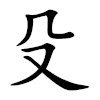殳
| ||||||||
| ||||||||
Translingual
| Stroke order | |||
|---|---|---|---|
 | |||
Han character
殳 (Kangxi radical 79, 殳+0, 4 strokes, cangjie input 竹弓水 (HNE) or 難竹弓水 (XHNE), four-corner 77407, composition ⿱𠘧又(GHT) or ⿱几又(JK))
- Kangxi radical #79, ⽎.
Derived characters
References
- Kangxi Dictionary: page 584, character 17
- Dai Kanwa Jiten: character 16613
- Dae Jaweon: page 977, character 5
- Hanyu Da Zidian (first edition): volume 3, page 2155, character 1
- Unihan data for U+6BB3
Chinese
| simp. and trad. |
殳 | |
|---|---|---|
Glyph origin
| Historical forms of the character 殳 | |||||
|---|---|---|---|---|---|
| Shang | Western Zhou | Warring States | Shuowen Jiezi (compiled in Han) | Liushutong (compiled in Ming) | |
| Oracle bone script | Bronze inscriptions | Chu slip and silk script | Qin slip script | Small seal script | Transcribed ancient scripts |
 |
 |
 |
 |
 |
 |
Characters in the same phonetic series (殳) (Zhengzhang, 2003)
Pictogram (象形) or Ideogrammic compound (會意/会意) : 𠘧 + 又 – a hand holding a tool, hence activity.
Pronunciation
Definitions
殳
- (historical) shu (an ancient Chinese weapon)
- 伯也執殳、為王前驅。 [Pre-Classical Chinese, trad.]
- From: The Classic of Poetry, c. 11th – 7th centuries BCE, translated based on James Legge's version
- Bó yě zhí shū, wèi wáng qiánqū. [Pinyin]
- My husband, grasping his halberd, is in the leading chariot of the king's [host].
伯也执殳、为王前驱。 [Pre-Classical Chinese, simp.]
- handle of halberd
- a surname
Etymology 2
| For pronunciation and definitions of 殳 – see 沒 (“not have; there is not; to be without; to be not so ... as; etc.”). (This character is the second-round simplified form of 沒). |
Notes:
|
Japanese
Vietnamese
This article is issued from Wiktionary. The text is licensed under Creative Commons - Attribution - Sharealike. Additional terms may apply for the media files.